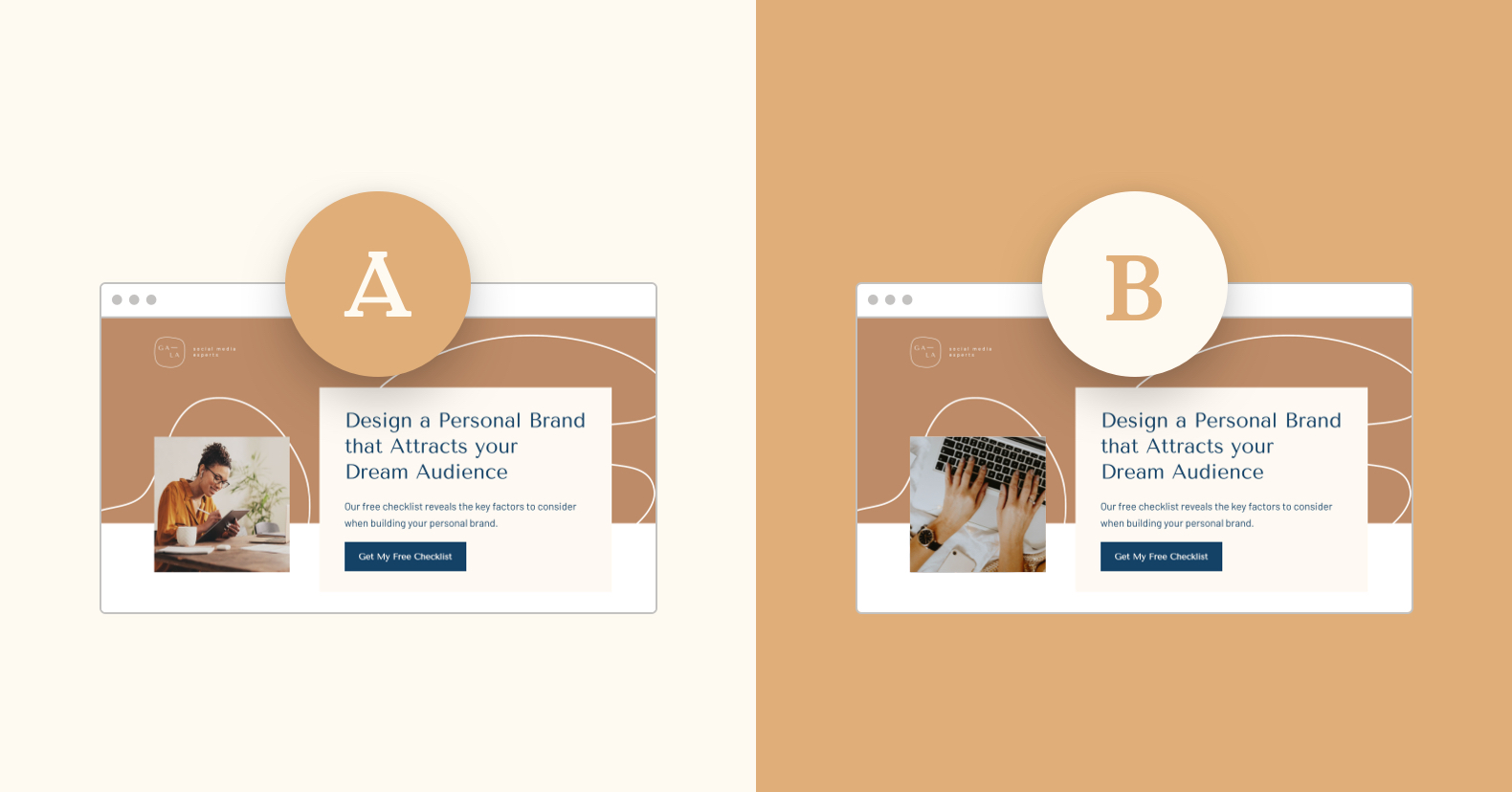
So you’ve finished building your landing page. Congratulations!
All there’s left to do is to go live, kick back with a glass of champagne, and smile as those conversions come flooding in…
Oh, if only it were that easy!
The first version of your landing page is exactly that: the first version. No matter how much upfront effort you put into creating a conversion-optimized page, you can only find out what actually works by testing the page against a slightly different version and seeing which one performs best. This is the essence of A/B testing.
For example, how could you tell whether your call-to-action (CTA) button should be bigger? What if a snappier headline would convince more visitors to convert? Would the presence of an on-page countdown timer help or hinder your sign-up rate? For all these questions and others like them, following your intuition or web design best practices will only get you so far. To discover the truth of what really works, you need to approach it like a scientist: you need to test.
In this post, we’ll cover the ABCs of A/B testing your landing pages. We’ll look at the benefits of testing, what to expect from it, what you should consider when deciding what to test, and how to put it all into practice right inside the Leadpages landing page tool. By the end of the post, you should have a good understanding of the basic mechanics of A/B testing and feel prepared to start running your own tests with confidence.
So first up, a quick refresher on A/B testing.
What is A/B testing and how does it work?
A/B testing (sometimes called “split testing”) is a method used for comparing two versions of a web page to see which performs best. When it comes to landing pages, this means pitting two slightly different variations of the same page against one another to see which one yields the highest conversion rate.
The way it works is pretty simple. First, you create a modified version of your landing page containing a single change—the “variable”—that you think could have a positive impact on your conversion rate. This could be something like the placement of your hero image, your headline font style, or the wording of your CTA. Then you randomly assign half your landing page visitors to the original version and the other half to the modified version. Once the test has run its course, you then compare the data from both versions of the page to see if your changed landing page had a positive, negative, or no impact on your conversion rate. If the change is positive, you can then adopt the modified version as your new, go-to landing page.
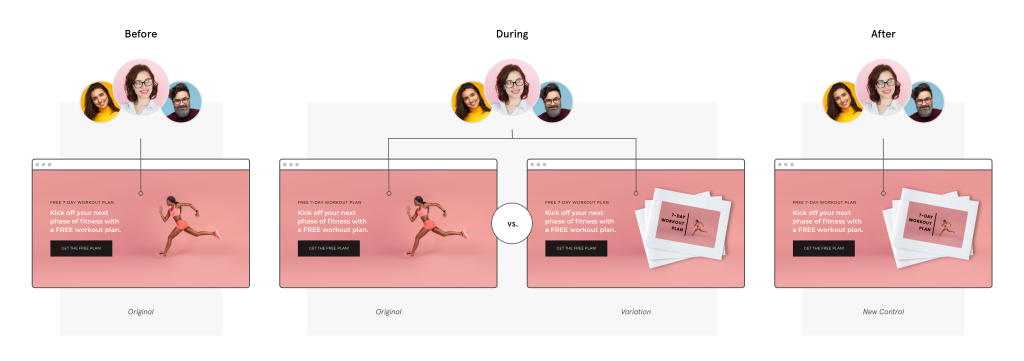
It’s important to appreciate that A/B testing isn’t a one-and-done type of activity. It’s an ongoing project of making incremental changes to your page in a bid to fine-tune your campaign for maximum conversions. Every test you run builds upon the test that came before it: even a negative result is useful in that it gives you a better idea of what won’t work when it comes to designing your next test.
You’ll often hear A/B testing being mentioned in the same breath as multivariate testing. The two methods are quite similar but have some important differences. While A/B testing compares two different versions (A and B) of a landing page by changing one variable at a time, multivariate testing instead compares multiple variables at a time.
Why do we do A/B testing?
There’s an old military saying that goes something like: “no plan survives first contact with the enemy”. The idea is that no amount of planning can fully predict how things will pan out when your plan is eventually put into action—when the unexpected happens, you need to adjust your strategy.
The same basic logic applies to your landing pages (although we don’t advocate thinking of your visitors as enemies!). Even your best guess of what will make your visitors most likely to convert is, in the end, just a guess. There could always be factors you haven’t considered and what you thought would work in theory may well pan out differently in practice. The fact is, what drives conversions for a given target audience on a given landing page is often unique and unexpected.
The beauty of A/B testing is that it ties the success of your sales and marketing campaigns to hard data instead of mere guesswork. By continually testing your assumptions, you end up discovering exactly what it is that drives your audience to take action so you can keep improving the conversion-friendliness of your landing page.
With that in mind, here are some major benefits of A/B testing:
A boon for the bottom line
At Leadpages, we’re constantly being reminded of how decisive A/B testing can be for business success. Our customers regularly demonstrate how a commitment to testing can result in huge boosts to their conversion rates—sometimes by as much as 300%. Since it takes a fair amount of time and money to generate new, high-quality traffic, the key is to get the most out of the traffic you already have. Whether you’re using your landing page to generate leads or to make sales, a better conversion rate will always lead to higher revenues in the long run.
Enhanced user experience
When someone visits your landing page, chances are they’ll have a specific goal in mind. Maybe they just came to learn more about your product or service, maybe they’ve already decided they want to buy from you, or maybe they’re just curious about who you are and what you offer. Whatever their goal, it’s important to make their experience on your page as frictionless as possible. Confusing copy, jarring color schemes, and hard-to-find sign-up buttons are all potential stumbling blocks that could detract from the user experience and, in turn, damage your conversion rate. A/B testing helps you identify these kinds of problem areas so you can adapt and create a more free-flowing user experience.
Low risk, high reward
Since A/B testing is an incremental process, with only single changes being made at each step, the risk of your conversion rate falling off a cliff during any given test is relatively minimal. And even if you do find that changing a certain variable causes a significant dip in your conversions, you can simply discard the change. Of course, if the change improves your conversion rate, then you’ve found something worth keeping!
More testing = better hypotheses
The discoveries you make by running A/B tests will improve your understanding of what drives your target audience’s behavior. And the better you understand your target audience, the better your future guesses will be when it comes to improving your user experience and conversion rates even further.
Examples of A/B testing success
If you’re still not fully convinced that it’s worth incorporating A/B testing into your campaigns, perhaps the following stories from some of our customers will sway you:
+34.43% conversions by using the right product image
We’ve often noticed that conversion rates increase when you include an image of your product in your opt-in box. One of our customers, Jae Jun at OldSchoolValue.com, tested the performance of two different images of his stock-analysis software package. The more modern-looking of the two images outperformed the more traditional-looking image by 99.76%.
+307% conversions by using the right headline
Award-winning author Amanda Stevens got dramatic results when she ran a simple headline A/B test on her eBook landing page. Her conversion rate skyrocketed just by switching her headline from “New Book Reveals Rescue Remedies for Retailers” to “If you’re a retailer in a need of fresh ideas and proven growth strategies, this book is for you!”
+28% conversions by removing the CTA
Leadpages customer, The Foundation, discovered that simply deleting the action-oriented headline on their video squeeze page boosted their conversions by 28%. Even more surprising: the Foundation team also ran the same test on their homepage. In both cases, the “no headline” variation won out by a significant margin. How’s that for counterintuitive?
A big thanks to all the Leadpages customers and small business marketers who have given us permission over the years to publish the results of their landing page A/B tests and split tests.
How to decide what to test
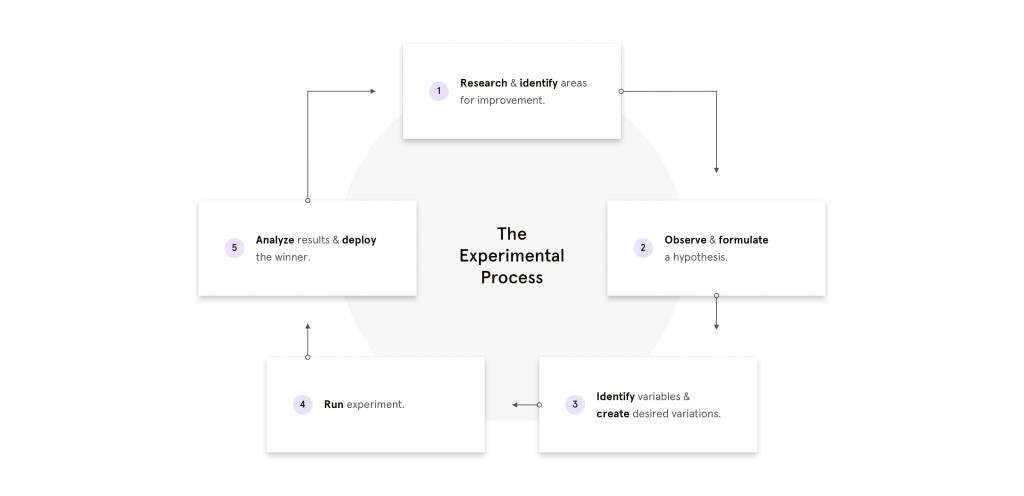
Okay. So you’re sold on the benefits of A/B testing and want to start running some on your own landing page.
The question is, where do you begin?
It wouldn’t make much sense to just start testing things at random. If you can’t think of any reason why your proposed change would have a positive impact on your conversion rate, then why should it have a positive impact when you try it out for real?
For quicker and better results, you need to base your hypotheses of what might work on the current performance of your landing page. There are multiple ways to gauge how well your page is performing, from analyzing the quantitative data found in your analytics to reviewing the qualitative feedback you get from test-driving the page with your colleagues or friends.
The basic point is to use all the data sources at your disposal to work out where your page could be doing better. For example, if your analytics show that 60% of visitors drop-off while they’re filling the sign-up form, maybe you should reduce the number of form fields. If your friend has trouble understanding what the page is selling, maybe your headline should be clearer. You get the picture.
To help you decide which tests to run first, we recommend you use the ICE prioritization framework. This framework poses three questions for you to answer when considering whether to run one test instead of some other test:
- Impact: How impactful do I expect this test to be?
- Confidence: How sure am I that this test will prove my hypothesis?
- Ease: How easily can I launch this test?
You should answer each question with a score from 1 to 10. The average of these three scores is your test’s overall ICE score. For example, let’s say you give your proposed test the following scores: Impact: 5, Confidence: 4, Ease: 8. In this case, your test’s overall ICE score would be 5.6. You can then compare this score with other proposed test scores to determine which tests to try out first.
A/B testing ideas for different parts of your landing page
Which variable you decide to modify during any given A/B test will depend on your goals and the unique details of your landing page. That said, modifying any one of the following key landing page features could have a big impact on your conversion rates:
Headline
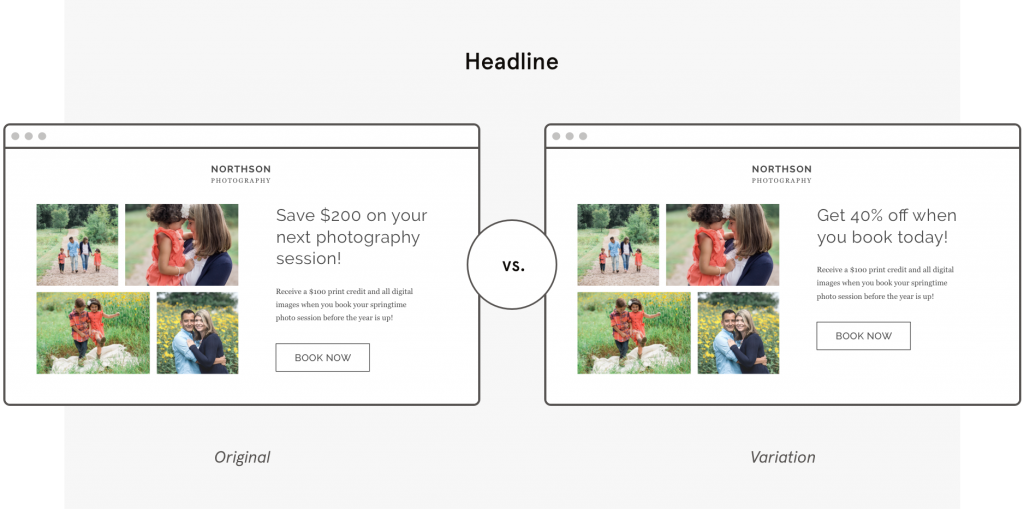
First impressions are everything and since your headline is the first thing your visitors will read, it’s essential to nail it. A bland, confusing, or irrelevant headline will deter many visitors from reading on and can thereby damage your conversion rate.
If you think your headline could use some work, try testing different title lengths, wording, and emphasize the main benefit that your visitors will get from whatever you’re offering. For example, instead of a generic headline like “Grab this eBook while you still can!”, try something more specific and evocative like “Learn the Success Strategies That Will Propel Your Music Career Forward”.
Crafting the perfect headline is often a balancing act. You want it to be compelling enough that people respond to your call to action, informative enough that people understand the value you’re offering, and brief enough that people don’t get bored or frustrated and leave the page.
Copy
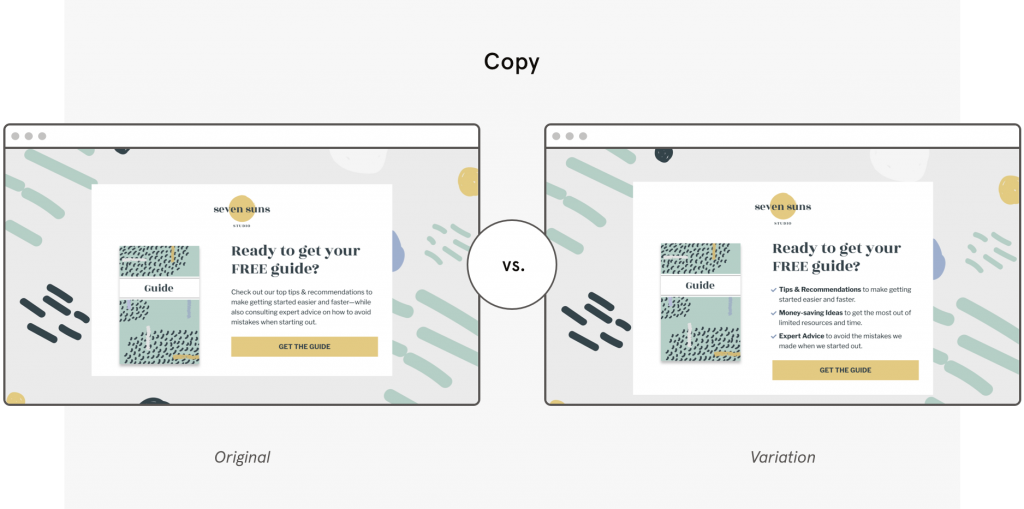
As with your headline, your landing page body copy should make it clear what value your visitor will get from handing over their contact details or payment info. Make sure that your copy also addresses any obvious questions and potential objections and try to strike the right tone for your audience.
It’s important not to overload your page with too many words since text-heavy pages can scare some people away. But if all the information you’ve included is essential, you should at the very least try breaking your text up into bite-sized chunks or bullet points so it’s easier to read.
Opt-in Forms
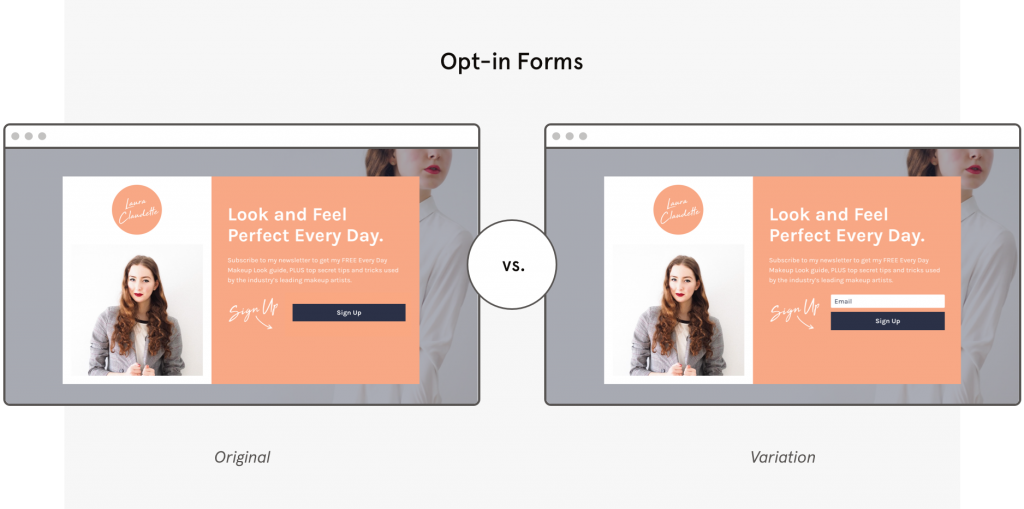
When it comes to opt-in forms, it’s usually best to keep the number of form fields to a minimum. Users may be put off entering their details if they think you’re asking for too much information. For most lead capture forms, all you really need is a name and email address—anything else is a luxury.
CTA Buttons
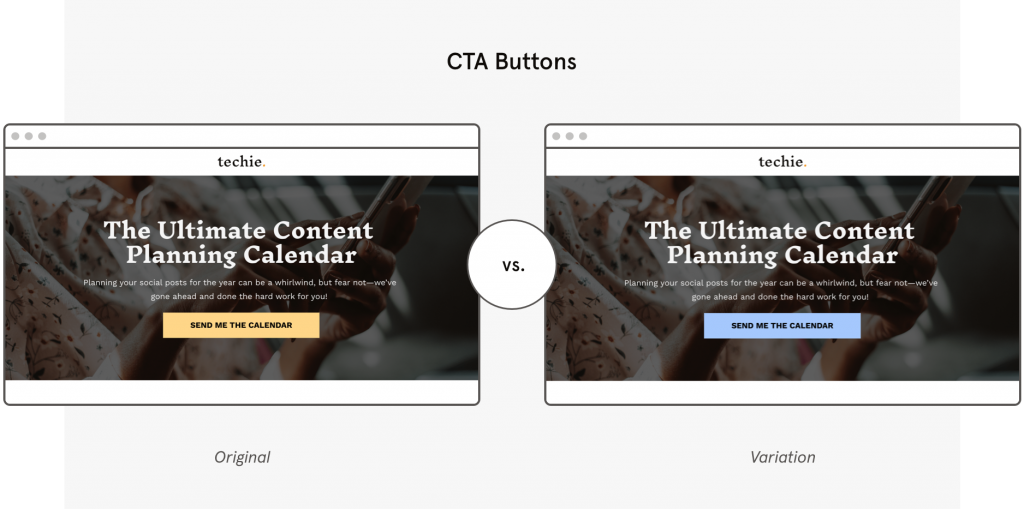
Your CTA button is the focal point of your landing page, where you prompt your visitors to take whatever step you need them to take. Given their extreme importance, it’s essential to make sure that your CTA buttons are clear, compelling, and easy to see. Any aspect of your CTA button could have an impact on your conversion rate, from placement to wording to color. Try out different variations to see what works best.
Countdown Timers
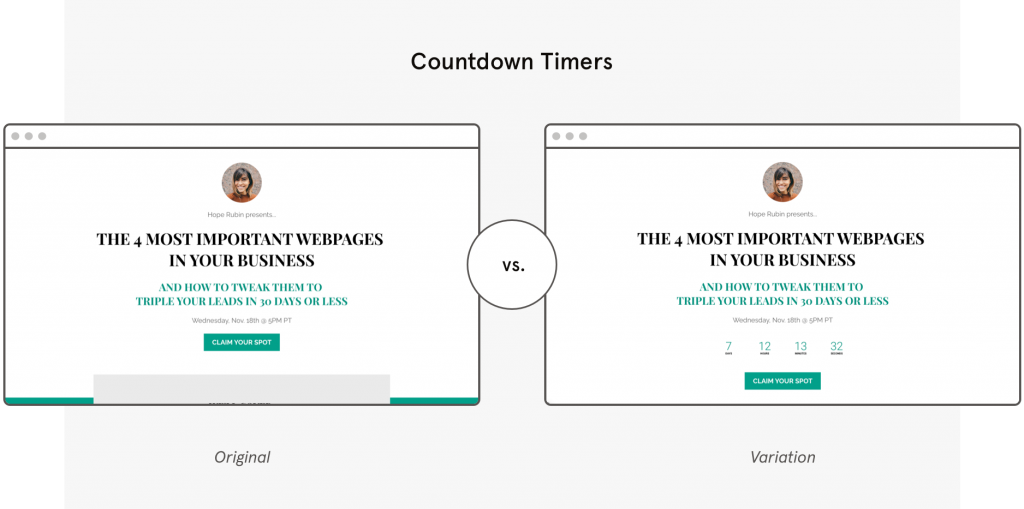
Countdown timers are a super useful tactic for creating a sense of urgency when visitors land on your page. The unmistakable, visual cue lets visitors know that the value you’re offering won’t be available for long and they’d better act now if they don’t want to miss out. If you’re promoting a limited-time offer, why not test to see if the presence of a countdown timer boosts your conversion rate?
Social Proof
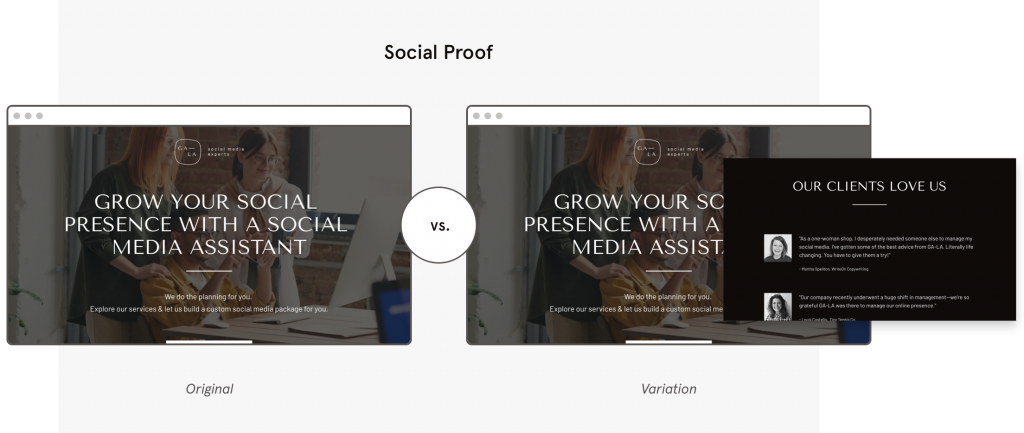
Adding some credentials, testimonials, or endorsements to your landing page can often improve conversions by increasing the perceived value and trustworthiness of your product or service. On the other hand, these elements are sometimes unnecessary and can detract from your CTA by cluttering your page. Which is the right option for your campaign? Well, there’s only one way to find out!
Price Points
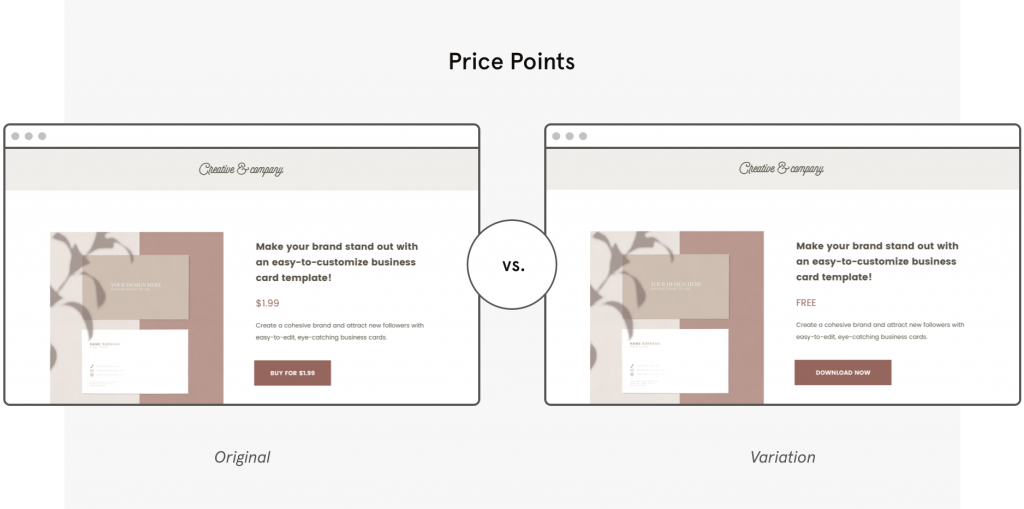
Pricing experts have understood the power of numbers for decades. In the minds of consumers, $4.99 seems a lot cheaper than $5, and, on restaurant menus, the dish listed as “bruschetta: $5” seems more expensive than the one that appears as “bruschetta: 5.” Try to use these subtle differences to your advantage by varying the way you present the numbers on your page.
Check out the infographic below for more ideas on what to A/B test on your landing page. You can also look at our guide to conversion rate optimization (CRO) for more tips on how to transform your page into a conversion machine.
How do you perform an A/B test in Leadpages?
So you’ve decided which element of your landing page you’d like to modify and test. How do you now put your A/B test into action?
Fortunately, if you’re already a Leadpages Pro or Advanced customer, you can easily run as many A/B tests as you like directly within our landing page builder. Here’s how:
- Inside your Leadpages dashboard, click “Create New Split Test”
- Find the page that you want to run a split-test on and select it as your Control
- Add a variation by creating a copy of your control, or choose a page you’ve already built
- Select the percentage of traffic you’d like each page to receive
- Review and launch your test!
For a more detailed breakdown of how to implement A/B tests in Leadpages, check out the video below:
3 mistakes to avoid when running A/B tests
While the basic principle underlying A/B testing is simple enough to grasp, putting things into practice can sometimes get a little tricky.
So before we finish, here are some of the most common mistakes to avoid when implementing your testing campaign:
1. Failing to account for past results in your testing
To get the most out of A/B testing, it’s crucial that you bear in mind your past findings when you consider what to test next. To do this you should keep an up-to-date record of all the tests you’ve run in the past, including any data of what worked and what didn’t. With these records at hand, you’ll have a much better chance of generating fruitful, data-driven hypotheses and avoid unintentionally repeating the same test twice.
2. Not running your test for long enough
How long should you run your A/B test? The answer to this question will vary from case to case, but one of the main factors to consider is how much traffic you receive. As with any statistical analysis, you need to make sure that your sample size is large enough for it to yield conclusive results. Put simply, the lower the traffic you receive, the longer it makes sense to run your test before declaring a winner.
3. Testing too many variables at once
Unlike multivariate testing, A/B tests work best when you limit yourself to one or two variables. This makes it much easier to identify which change, if any, led to a positive impact on your conversions. Use the ICE framework mentioned above to prioritize your testing roadmap.
Time to put A/B testing to the test!
We’ve seen how A/B testing can be an extremely powerful method for reliably improving landing page conversion rates. By helping you pinpoint what works and what doesn’t, A/B testing paves the way for more successful, revenue-generating campaigns.
Now it’s your turn to start putting these ideas into practice. Let this post be your guide and don’t be afraid to make small mistakes—after all, a big part of A/B testing is figuring out what works by figuring out what doesn’t work.
Don’t forget that Leadpages Pro and Advanced customers can run unlimited A/B tests directly within our landing page builder. So if you haven’t already signed up, why not start your 14-day free trial today?



